August 16, 2019
Air Date: August 16, 2019
FULL SHOW
SEGMENTS
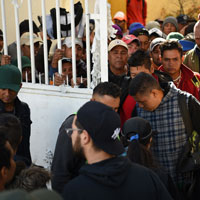
Climate Migrant Caravans
View the page for this story
Toward the end of 2018, Central American migrant groups of several thousands of people began journeys towards the United States. Many are fleeing a massive drought that has lasted for five years. John Sutter, Senior Investigative Reporter for CNN, joins Living on Earth's Bobby Bascomb to take a look at the ties between climate change and the migrant caravans. (10:20)
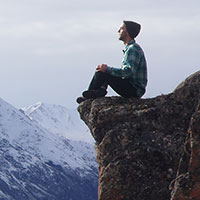
The Place Where You Live: Anchorage, Alaska
/ Sasha JohnsonView the page for this story
Living on Earth gives a voice to Orion Magazine’s longtime feature, “The Place Where You Live,” in which readers write about their favorite places. In this week’s edition, teacher Sasha Johnson shares her essay on living in Anchorage, Alaska, a place of bold, adventurous folks willing to endure hardship in chasing their dreams. (06:14)
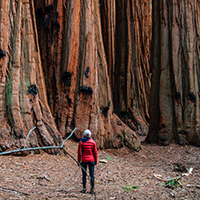
Exploring the Parks: Sequoia and Kings Canyon
View the page for this story
This installment in Living on Earth’s occasional series on America’s public lands takes us to Sequoia and Kings Canyon National Parks in California, which boast some of the biggest trees in the world and the tallest peak in the lower 48 states. Savannah Boiano of the Sequoia Parks Conservancy talks with Host Bobby Bascomb about the highlights of these jewels of the national parks system, including the giant sequoia trees as well as hundreds of miles of hiking trails. (08:39)
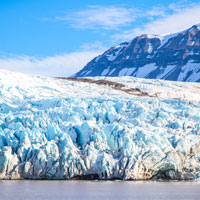
Confronting Climate Change Through Sound
/ Sandy HausmanView the page for this story
The seemingly constant onslaught of grim statistics and graphs about climate change may cause some people to shut down, unwilling or unable to process one of the most serious environmental issues of our time. To draw people back into a conversation about our changing climate, researchers at the University of Virginia are using something called eco-acoustics – sounds that illustrate the relationship between humans and their environment. Reporter Sandy Hausman has the story. (04:09)
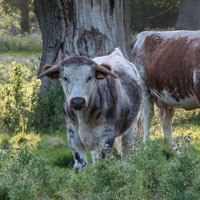
Rewilding The English Countryside
View the page for this story
When an agricultural estate in West Sussex, England that had been in one couple’s family for generations was no longer a fruitful venture, they decided to let nature take its course. Author Isabella Tree tells Living on Earth’s Bobby Bascomb about the ecological and financial benefits of letting nearly six square miles of previously cultivated landscape go back to nature. Her estate today brings income from game meat and ecotourism, and offers a glimpse into what rural England might have looked like before agriculture. (16:54)
Show Credits and Funders
Show Transcript
HOSTS: Bobby Bascomb
GUESTS: Savannah Boiano, John Sutter, Isabella Tree
REPORTERS: Sandy Hausman, Sasha Johnson
[THEME]
BASCOMB: From PRI – this is an encore edition of Living On Earth.
[THEME]
BASCOMB: I’m Bobby Bascomb.
Trying to hold back the tide of migration from Central America may well be going against the tide of climate disruption.
SUTTER: This is a time of walls, you know? We're putting up barriers here, elsewhere in the world, trying to slow the movement of people, when we know, in just this one way, that there's going to be this macro problem of climate change that is going to push people out of their homes, and I think that's something that we have to reckon with.
BASCOMB: Also, when farming could no longer pay the bills, a family in the English countryside decided to let nature take over.
TREE: Going from intensive management, where you're really manipulating everything and tidying up and managing the land to the nth degree, to just sitting back and letting go is a massive mind swing.
BASCOMB: Using native animals to manage the land. That and more this week on Living on Earth – Stick Around!
[NEWSBREAK MUSIC: Boards Of Canada “Zoetrope” from “In A Beautiful Place Out In The Country” (Warp Records 2000)]
[THEME]
BASCOMB: From PRI and the Jennifer and Ted Stanely Studios at the University of Massachusetts Boston, it’s an encore edition of Living on Earth. I’m Bobby Bascomb, in for Steve Curwood.
Climate Migrant Caravans
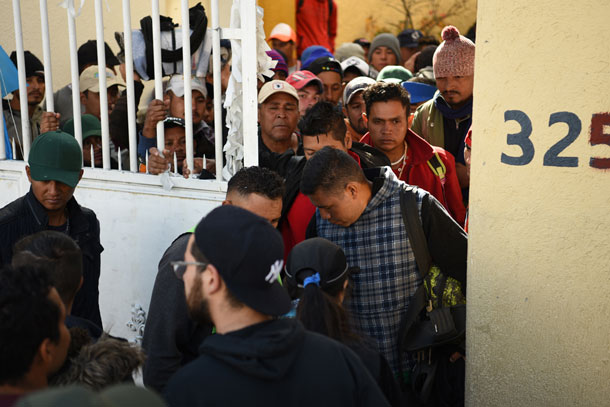
Many of the Central American migrants seeking asylum have been driven to desperation by the impact of climate change, extended drought and shifting growing seasons, which have led to crop failure. (Photo: Daniel Arauz, Flickr, CC BY 2.0)
BASCOMB: Migrants from Central America present themselves on our southern border on a daily basis asking for asylum. Families from Guatemala and Honduras seek sanctuary for a variety of reasons, including attempts to escape gang violence and poverty. And a less visible factor is climate disruption. John Sutter is a Senior Investigative Reporter for CNN who went to rural Honduras to report on climate change and immigration. He started by looking at the story of an individual family.
SUTTER: One woman I met... her name was Delmi Amparo Hernandez. And she's living in a pretty small village on a mountaintop in Copán, just very near the Guatemalan border, actually. And her husband left in one of the caravans last year. Germán was his name. For the last five years, this region has just been hit with this intense drought. And you know, they’re subsistence farmers, completely reliant on maize crops. Their family was really struggling, and so when he heard about the caravan coming through, like, you know, many other people I met, he made almost a decision in that moment to go and join them. And so, you know, she was left behind with her children. And I found it just really heartbreaking that she, and some other people I met, really had almost no way of knowing what happened after that point. So he left without a phone, he left with a phone number in his pocket in case he found a way to call back, and to call a neighbor in this village and let her know how things were going. In a lot of the places I've visited, there's just this incredible, real sadness in that there are so many people and a lot of, like, working-age adults who are missing, and single parents left behind to try to fend for their families and fill in that void.
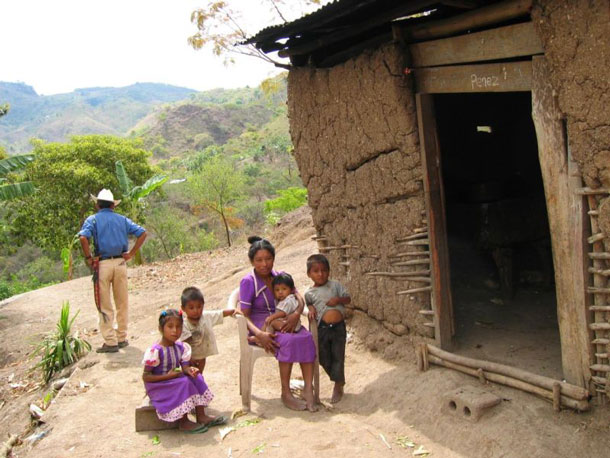
The spring rains in Central America are crucial to the growth of the corn crop, which itself is crucial to the Central American diet. For the last five years, the rains have either arrived in the wrong season, or sometimes not at all. (Photo: André Schütte, Wikimedia Commons, Public Domain)
BASCOMB: Now, tell me a bit about the drought that forced him to make that difficult decision. How long has it been going on? And in what ways is it impacting people there?
SUTTER: So this drought has lasted about five years. And in some places, it's hit harder than others. There's what's called the dry corridor of Central America, which, as that name suggests, it's normal, that the dry corridor would be dry. But some of the climate scientists I've talked to say that in the last number of years, they've started to see some things that seem unprecedented. In particular, spring rains, which are incredibly important for corn crops, which is, a staple in this region that they just haven't been coming. Like, they're almost completely missing when you look at the average rainfall by the month. So it's partly that rains have decreased, it's partly that they've shifted and are no longer falling in the seasons when they have been, you know, so useful the farmers in the past. But it's been very troubling and created a lot of hardship because it's important to realize that this lot of people in the dry corridor of Central America are subsistence farmers. They're living day to day. In other parts of the world, like the US and parts of Europe, there are crop insurance programs and other ways to tide you over in bad years of farming. There, that's, you know, not the case and often there's no irrigation system. So if it's not raining, you don't have a way to pump water in from a canal or from the groundwater to supplement your crops. They just don't grow. And so I think that's why there's been such an intense crisis there. I mean, the UN Food and Agriculture Organization says there are 2 million people in this region in the world who are at risk for hunger. It's not like they've never seen drought before, but this one has been particularly intense and troubling for farmers there.
BASCOMB: You write in your story that corn and bean crops are failing, and those are staple crops in the region. And, I know that corn is king there. I mean, people eat corn tortillas for breakfast, lunch, and dinner every day, literally. So I can imagine that if the corn crop is failing, as you mentioned, you're looking at massive malnutrition and even starvation. This is a really desperate situation.
SUTTER: Yeah, it really is. And I think that's another thing people underestimate about the caravan or any migration story, really, when you hear about it. It has to be really bad for you to want to flee a problem. There's an incredible attachment to a sense of home and place, especially among people who are farmers, and who are attached to the land. It's a big deal to think about leaving, and that gives you a hint at like, how intense the situation is, for many farmers. The experts on hunger, on starvation, people with the UN, for example, who I spoke with, they all say that this stuff is cumulative. If you have one bad year, and the rains don't fall, that creates a certain stress. If you have year, after year, after year, and at this point, essentially five years of very bad drought conditions, then that's where you start to create conditions that can lead to hunger, starvation, these truly serious problems.
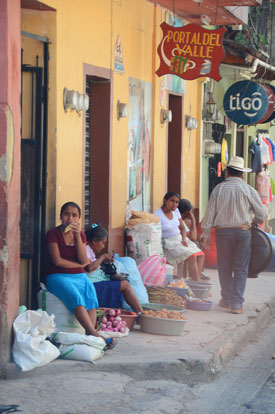
Copán, Honduras, was originally a thriving tourist destination, but drought-induced crop failure has led to an economic downturn and many climate refugees have fled their land. (Photo: Alex Keshavjee, Flickr, CC BY-NC 2.0)
BASCOMB: Now, you quote the Commissioner of the US Customs and Border Protection in your article. And he says that crop failure directly translates to who is arriving at our border. But President Trump has been widely saying that immigrants in our southern border would be terrorists and drug dealers and things like that. It sounds a bit like the left-hand doesn't know what the right hand is doing.
SUTTER: Yeah, I mean, I think that that's the case with several of the agencies, right? But I was surprised that, you know, that officials were saying this is part of what's happening, and if that they had that awareness, I thought that was encouraging actually. I wish that the administration, or really anyone in Washington, would talk about this issue of migration in terms of climate change, because the projections for how many climate migrants or climate refugees there will be in the world are uncertain. And we're not preparing for that. If anything, the United States and European countries are doing the opposite, right? Like, this is a time of walls. You know, we're putting up barriers here, elsewhere in the world, trying to slow the movement of people, when we know that in just this one way, that there's going to be this macro problem of climate change that is going to push people out of their homes. And I think that's something we have to reckon with.
BASCOMB: Here on the news, we're hearing that a lot of this migration is due to gang violence and murders, you know, violent crime that's forcing people to leave their homes. But you write that the data doesn't really show that. Can you tell me about that?
SUTTER: Yes, it certainly really doesn't show that for this region, the area of Western Honduras where we spend our time and that we went to basically, because of the data that we saw. The crime rate has been going down in recent years. And we got data from the US Border Patrol that showed the sort of place of origin of people who were apprehended at the US border, and there was just this big percent increase, this spike in people coming from Western Honduras. And so I think migration stories are always complex. But I think it's not untrue, that violence is driving people out. It's not untrue, that poverty is driving people out. But it is also true that climate change and severe drought are causing people to move from that region, and from others. And I think that we have to look at that in a clear-eyed way. And think about what that means. Because the United States…we've done more than any other country to cause warming. The planet has warmed about one degree Celsius already because of people burning fossil fuels and other activities. And we're responsible for a good chunk of that. And that warming is displacing people now and is projected to displace, you know, ever-larger numbers of people moving forward. And so I think it's this really important moral question we need to ask ourselves. We're causing this hardship in parts of the world, many of us may never travel through or never see, but that stuff is real. And it's causing repercussions, one of which is that people are on the move to try to make ends meet, to try to make a livelihood, and to try to keep their lives moving. And so I think for me, it doesn't invalidate the other stories that we've heard about the caravan, but it certainly complicates them. And there's another layer to that story that I think isn't being told.
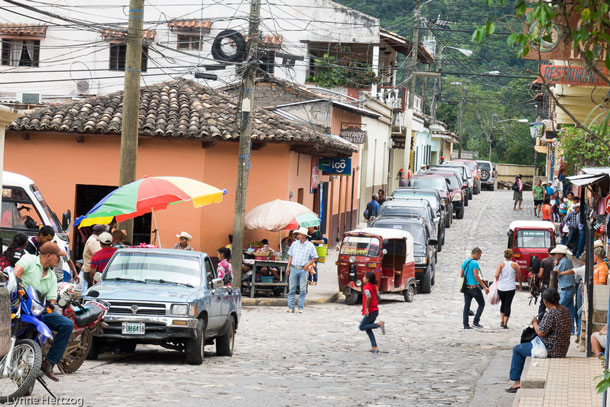
The story of Delmi Amparo Hernández and her family is an increasingly common one. In 2012, before the drought, only 3.7% of Honduran migrants came from the area surrounding Copán. These days, that percentage is over 9%. (Photo: Lynne Hertzog, Flickr, CC BY-NC 2.0)
BASCOMB: By the way, before you leave us, what happened to the family that you talked about at the beginning of our chat here? What happened with her husband, and how did their situation unfold?
SUTTER: Delmi, who is one of the people I met on this trip, her husband left in the caravan. She went next door to a neighbor's house, basically to check on a TV, to look on the TV news for coverage at the caravan to see if she could spot him. And instead, she and other people in Central America were seeing these images of, you know, people jumping off of bridges to try to make it across borders, being met with tear gas at the US border in Tijuana. But in Delmi’s case, she found out from like a stunning phone call that she got, that her husband died on the path north. And that happened in Guatemala. She doesn't know a whole lot of details around exactly what happened. She showed me, you know, what documentation she did have. But she's just stunned and in grief and trying to figure out how to take care of their children alone. The people in her community are helping her, the group World Vision actually has been delivering her food from time to time. To me, it speaks to the extremity of the conditions down there, and how desperate this man was to provide for his wife and his family. And he paid, you know, the ultimate price for that.

John D. Sutter is a Senior Investigative Reporter for CNN (Photo: Courtesy of CNN)
BASCOMB: Well, you mentioned that this one family is getting some help from their neighbors and some assistance from NGOs. But looking at the larger picture, I mean, what kind of help is there for struggling Central American farmers? I mean, are they getting aid from international organizations or their own government?
SUTTER: I think that's the one really hopeful part of this story, right, is that in a piecemeal fashion, there are, you know, NGOs and some governments that are trying to fund, like, projects in the dry corridor of Central America to make farming a little easier. I mean, the main thing, one of the main things that can happen is irrigation projects, right? If you have an irrigation system, and you can tap water, when it isn't falling from the sky, you're a lot more resilient to the effects of climate change. Climate change happens in the margins. It's not like droughts never happened before or hurricanes never happened before. But climate change makes these things worse. And that can push people over the edge into situations of starvation, or migration, or all these things we've been talking about. So I think anything the international community can do to invest in some of those projects is smart. And depending on who you talk to you, there are climate policy experts who think that the big industrialized countries of the world, the US, Europe, China, that we owe that to places that are dealing with the effects of climate change and that have done little if anything to cause it.
BASCOMB: John Sutter is a Senior Investigative Reporter for CNN.
Related links:
- CNN | “One Suspected Driver of the Migrant ‘Caravan’: Climate Change”
- Click here to hear our previous coverage of Central America’s Climate Refugees
- The Guardian | “The Unseen Driver Behind the Migrant Caravan: Climate Change”
[MUSIC: Chancha Via Circuito, “Los Pastores” on Bienaventuranza, by William Centellas, Wonderwheel Recordings.]
BASCOMB: Coming up – Exploring the rugged Sequoia and Kings Canyon National Parks. That’s just ahead on Living on Earth.
ANNOUNCER: Support for Living on Earth comes from Sailors for the Sea and Oceana. Helping boaters race clean, sail green and protect the seas they love. More information at sailorsforthesea.org.
[CUTAWAY MUSIC: Chancha Via Circuito, “Los Pastores” on Bienaventuranza, by William Centellas, Wonderwheel Recordings.]
The Place Where You Live: Anchorage, Alaska
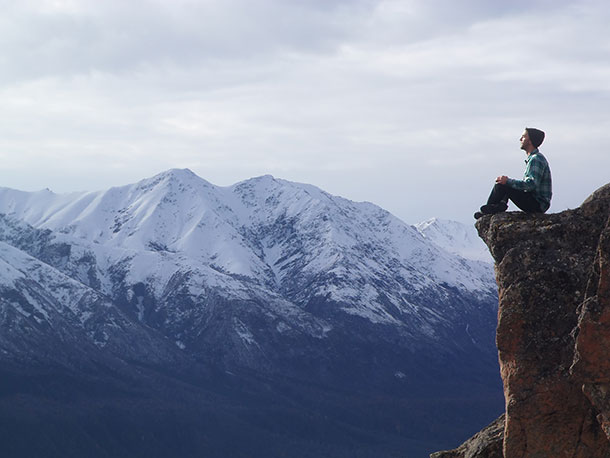
In her essay for Orion Magazine, Sasha Johnson writes, “We head to the backcountry in Hatcher Pass, find ways to make the winter last through summer’s short gasp.” (Photo: Sasha Johnson)
BASCOMB: It’s Living on Earth, I’m Bobby Bascomb.
[MUSIC: Edward Sharpe and The Magnetic Zeroes “Home” from Edward Sharpe and The Magnetic Zeroes, Rough Trade Records, 2009]
BASCOMB: We head to Anchorage, Alaska now for another installment in the occasional Living on Earth/Orion Magazine series The Place Where You Live. Orion invites readers to submit essays to the magazine’s website to put places they care about on the map, and we give them a voice.
[MUSIC: Mary Youngblood “Within My Heart” from Beneath the Raven Moon, Silver Wave Records, 2002]
JOHNSON: My name is Sasha Johnson, and this is my essay called, “Anchorage, Alaska.”
Anchorage, Alaska. Home and point of departure. Nestled along a sloping peninsula between the mountains and the sea. Young, adventurous, bold. Addicted, drunken, old. Squeezing out the space between the Chugach and Cook Inlet, climbing up the hillside, stretching north and south. Digging and drilling and mining and tilling. Disorganized as driftwood. Sliced up and down by the highway, tucked into neighborhoods cockeyed and rent-choked. Sporting proud your homes on the heights overlooking the bore tide rolling in Turnagain Arm, eagles and geese flying low over Potter Marsh, with a view to Fire Island where the windmills eke out their promises. You bedeck your winter streets with gravel, coat them with ice and snow, groom them with snowplows and brush them clean for summer.
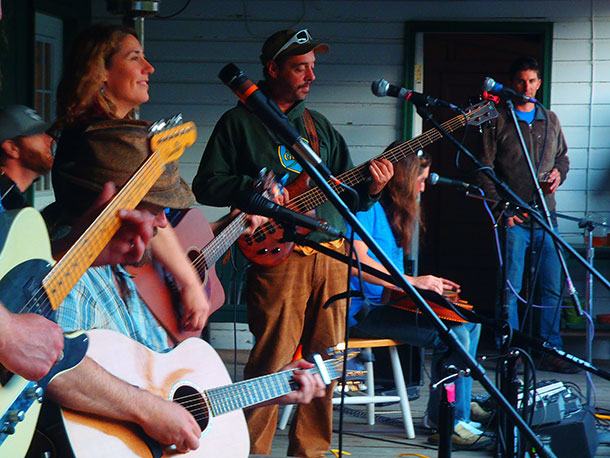
The “homegrown song” Sasha Johnson mentions in her essay was by local band Melissa Mitchell and the Sociables, in Hope, Alaska. (Photo: Sasha Johnson)
We live outside in all weathers, we hitchhike, we hold cardboard signs. We head to the backcountry and Hatcher Pass, find ways to make the winter last through summer’s short gasp. We roost with the ravens and run Native Corporations. We are mountaineers and mistresses, hobos and halibut fishermen. We dip-net for salmon and hunt oil on the North Slope, two weeks on, two weeks off. Bush pilots and line cooks, airmen and officers, bankers and railroaders, coal men and climbers.
We call you home, Anchorage, you beggar, trouble-maker, reckless one, dreamer. Heart of Alaska. Independent and willful but keen for community, just a big city spread with a small-town rumor. Let’s drive out to catch the festival. I’ll listen to your music again by anybody’s fire, barefoot, eyes closed, rocking the stage with homegrown song. Taste your salmon, smoked and grilled and salty on my tongue. Feel your cold bite in the morning. Catch the scent of sprucewood and birch, wet with dew.
I head over a sunset ridge and you disappear from view.
[MUSIC: Mary Youngblood “Within My Heart” from Beneath the Raven Moon, Silver Wave Records, 2002]
JOHNSON: I have lived in Anchorage for two years only. It’s new for me. But I’m 36 and it’s the first place that I ever felt like I could really call home. And I had that feeling immediately in the geography, in the landscape, the mountains, the rivers, the forests, and then in the people. The people felt like my people for the first time. Strange, eccentric, adventuresome people who were willing to risk, who loved the outdoors and were willing to fight for what they wanted, even if it isolated them from other people. I felt a kinship with those people.
I teach, but I also ski. And I know mountaineers and I’ve spent time with them. I wanted to be a bush pilot. And I’ve seen all of our homeless tramps and hobos on the street. So, these are familiar faces to me, these are people I’ve known and some of them are things I’ve done. Some of the references in this essay are experiences I’ve had. Some of them are people I’ve known and some of them are things I hope to do. I see Anchorage as a place of dreams for many people and some of these dreams are broken.
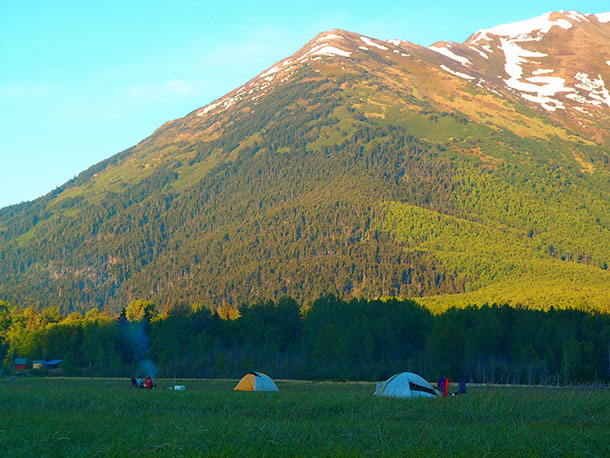
“Heart of Alaska. Independent and willful but keen for community; just a big city spread with a small town rumor," writes Sasha Johnson in her essay. (Photo: Sasha Johnson)
Everybody that I’ve met has a story and not all of them want to tell that story. There are many reasons why people come to Alaska and end up in Anchorage and you can feel the yearning in the stories of the people that you get to meet. You see poverty, you see wealth, you see people struggling daily all around you and you see success. Families, children. It’s a place where people struggle to make it and struggle to build a life. And it’s a beautiful place but it’s a place – you can feel the struggle.
[MUSIC: Mary Youngblood “Within My Heart” from Beneath the Raven Moon, Silver Wave Records, 2002]
CURWOOD: That’s Sasha Johnson on her new home in Anchorage, Alaska. You can find pictures and details about Orion Magazine and how to submit an essay about the place where you live, at our website, loe.org.
Related links:
- Sasha Johnson’s essay in Orion Magazine
- Sasha Johnson’s Flickr account
- More on the band Sasha mentions
- The Place Where You Live essays in Orion Magazine
[MUSIC: Sharon Jones & the Dap-Kings, "This Land is Your Land" on Naturally, Daptone Recording Co]
Exploring the Parks: Sequoia and Kings Canyon
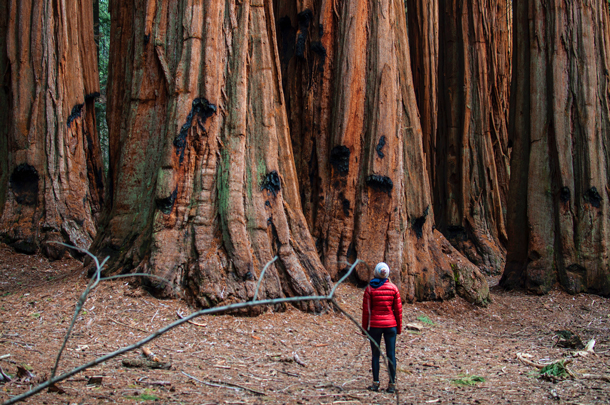
Giant sequoias are the largest trees on earth by volume, and with a lifespan of more than 3,000 years, they’re among the oldest. (Photo: Vitto Sommella on Unsplash)
BASCOMB: The latest installment in our “Exploring the Parks” series brings us to the ancient trees and jagged peaks of Sequoia and Kings Canyon National Parks. The two contiguous parks offer a huge diversity of habitats. At more than 14,500 feet, Mount Whitney is the tallest mountain in the contiguous US, and habitat for animals including pika, a mountain dwelling cousin of the rabbit….
[SFX PIKA SOUNDS]
BASCOMB: And bighorn sheep…
[SHEEP GRUNTS]
BASCOMB: Much lower, at just 2,000 feet, you can hear the dawn chorus at Big Oak Flat, featuring the dark eyed junco, oak titmouse, and the northern flicker.
[BIRD SOUNDS]
BASCOMB: Add in some of the largest trees in the world, the sequoias, and Sequoia and Kings Canyon National Parks have a lot to offer. Our guide to the parks is Savannah Boiano, the Executive Director of Sequoia Parks Conservancy. Welcome to Living on Earth!
BOIANO: Thank you, thank you for having me.
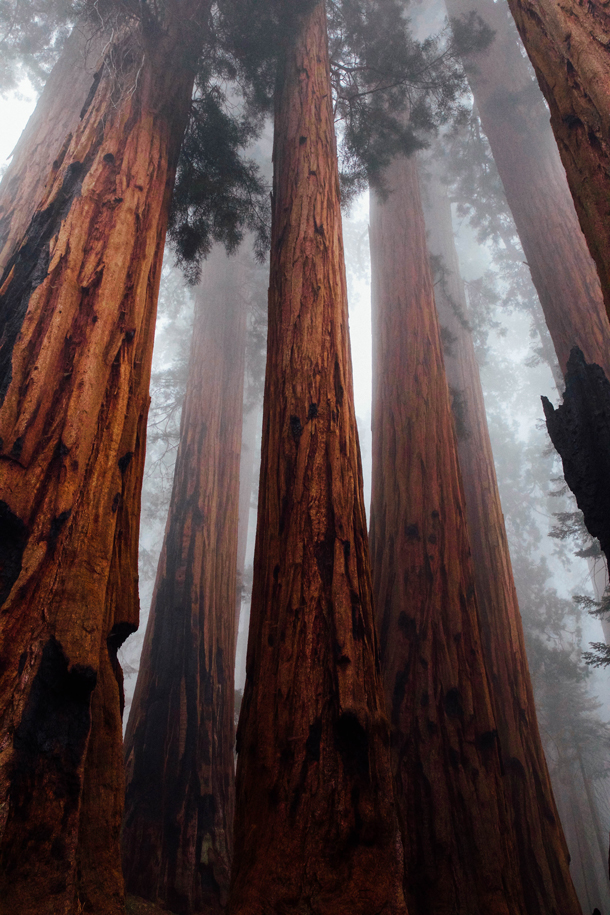
Giant sequoias shrouded in mist. (Photo: Victoria Palacios on Unsplash)
BASCOMB: For someone that's never been to either of the parks, can you sort of describe them before me, you know, paint a picture of what they look like there.
BOIANO: Oh gosh, they are stunning jewels. So Sequoia National Park and Kings Canyon National Park both lie in some of the steepest section of the Sierra Nevada. For those familiar with California, typically people are familiar with the Sierra Nevada kind of in regards to Tahoe or Yosemite National Park, and those landscapes were heavily glaciated, and they're more rounded and kind of more user-friendly in a lot of ways. And when you go south in the Sierra Nevada, things tend to get very, very steep. And so if you're looking at 14,000-foot peaks, Sequoia and Kings Canyon National Park have the majority of the 14,000-foot peaks for the Sierra Nevada, our highest being Mount Whitney. So Sequoia National Park starts at about 1,000 feet and goes up to 14,495 feet at Mount Whitney. And then Kings Canyon National Park starts in the, you know, 6000-foot range, goes up, and then goes precipitously down into a beautiful canyon; kind of rivals Grand Canyon as far as the depth of the canyon. So, we have a very dramatic landscape. And because of that dramatic landscape, it is considered an International Biosphere Reserve and it protects some of these beautiful life zones going from the foothills all the way up to the alpine regions.
BASCOMB: And I've read that there's over 800 miles of maintained trails in the parks, but the majority of them are only reachable by backpacking. What do you recommend for people that might be interested in doing something like that?
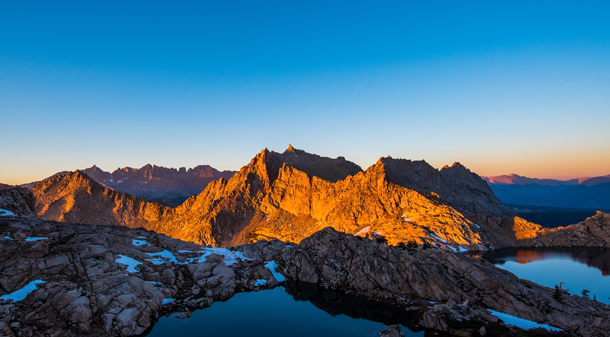
Spectacular views abound in the steep high country of Sequoia and Kings Canyon National Parks. (Photo: Siddharth Dedhia on Unsplash)
BOIANO: There are so many backpack trips here. The Rae Lakes loop in Kings Canyon National Park is very popular, you head out from Cedar Grove and walk from the end of a road all the way up into this beautiful subalpine valley with turquoise-colored lakes and wildflowers and a ranger station. There's one area actually, or a couple areas, where you can backpack into giant sequoia groves, and spend your night under those giants, looking up into those towering trees. And then in Sequoia National Park, some of the best backpacking, or most popular backpack spots, are out of the Giant Forest area which take you towards the Mount Whitney region, or even out of Mineral King where you're jumping off into the wilderness from about 8,000 feet and going up into the subalpine and alpine regions.
BASCOMB: It sounds like you have to be in pretty good shape; is this something that you think would be a family-friendly endeavor?
BOIANO: Yes, actually, you know, my husband and my daughter and I started backpacking the Sierra Nevada when she was four. We decided that she could go one mile per year of her life. So you know, she started off at four, and we went four miles for that day. And then we had a camping spot that we had picked out. And every year we add a mile to her age, and this year, we'll add a mile and we'll do, you know, 11 miles and that could be over, it'll probably be a day, but it could be over the course of two days. And then we'll find a backpack trip. So you know, some of it is with preparation before you come to the parks and knowing what your limits are. And knowing that you're going to be traveling at the speed and the ability of the least experienced or the slowest person in your group. And if you know all of those things beforehand, it can be very doable as long as you're kind of maintaining those expectations.
BASCOMB: So for somebody that's maybe not quite ready to hike the tallest mountain in the contiguous United States or you know, hike 11 miles with their child, is there something you can recommend for just a day or two, to sort of get a feel for the parks?
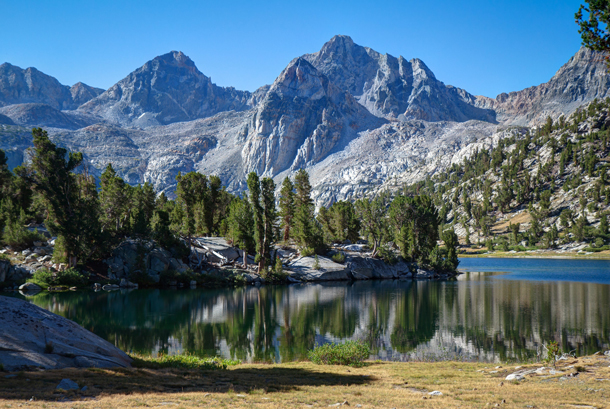
The Rae Lakes Loop is a popular backpacking route through Sequoia and Kings Canyon National Parks. (Photo: Flickr CC BY-NC 2.0)
BOIANO: Oh, my gosh, yeah. So of course, you want to come to these parks, and you want to check off some of the very popular features. And they're popular for a reason, because they're just stunning opportunities to experience, you know, America's national parks. So, I really like sending people to see the General Sherman tree. It is beautiful, and it's majestic, and you get a sense of perspective and size and your own size. And within the Giant Forest alone, you know, not only seeing the General Sherman tree, but there's 40 miles of walking trail just in that grove alone. Within that grove, you can hike up Moro Rock and stand perched above the giant sequoia grove and look down on that.
BASCOMB: Yeah, these trees are just so huge. It's almost, I think, hard to wrap your mind around the size of them, and the longevity.
BOIANO: Yeah, they're a sight to behold. You know, they're not the tallest trees in California, that distinction goes to the coast redwoods, where they are a full 10-story building taller than a giant sequoia. But when you get to the giant sequoia zone, those trees are much larger than their cousin, the coast redwood. They are bigger by volume, so they're a lot wider at their base. You know, for some of the monarch, the biggest at its base would be the General Grant tree. And the General Grant tree in Kings Canyon National Park, you could take a motor coach, park it lengthwise behind the General Grant tree and just make out the windshield wipers and the tailpipe.
BASCOMB: Wow, amazing. Now, I understand another thing that is popular in the parks is stargazing, and you are in a pretty good position for that. Can you tell me more?
BOIANO: Yeah. You can, whether you're staying at a park lodge or you're in the campground, or you're just, you know, late into the night, you can go on top of Moro Rock and on a full moon you can watch the full moon rise and the sun set, from that vantage point. It is a pretty cool experience. And then, you know, on a new moon, when everything is dark, you can be at one of our park lodges and go outside and just take a few steps from the lodge itself and look up and see really dark skies.
BASCOMB: Now, do you have a personal favorite, or a story that really stands out to you in your experience in the parks that you like to share with people? You know, a highlight of your experiences there?
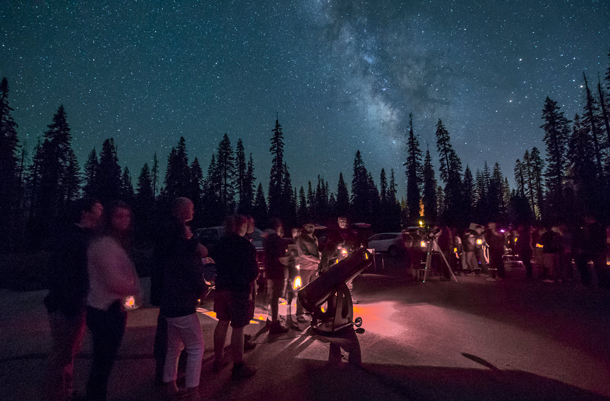
The Sierra Nevada mountains are a great place for stargazing, and Sequoia and Kings Canyon National Parks feature a Dark Sky Festival each August. (Photo: Cade Castle and Alison Taggart-Barone, courtesy of Sequoia Parks Conservancy)
BOIANO: Oh, I think you know, Moro Rock and watching the full moon rise over Moro Rock and watching the sunset is an incredible experience. I do tend to like backpacking myself; it just kind of takes me away from the office and technology and allows me to really spend some quality time with my family. And you know, we go nice and slow and enjoy the things along the way. Last year, you know, my daughter and I went up towards Hockett Meadow out of Mineral King. And we just took our time, and we found so many pika and chatted with them, and saw the birds. And so for me, going into the backcountry, it's not the distance, it's the journey of unhitching myself and my daughter from, you know, everyday life and just reconnecting, and I think that's one of the things that's great about Sequoia and Kings Canyon National Park. It's not as developed as other parks in California. And so it really is an opportunity to disconnect from things, and reconnect to those, you know, you're traveling with, or even yourself.
BASCOMB: Savannah Boiano is the Executive Director of Sequoia Parks Conservancy. Savannah, thank you so much for taking this time with me today.
BOIANO: Well, thank you for having me. It's been a pleasure.
Related links:
- Plan your visit to Sequoia and Kings Canyon National Parks
- About the Sequoia Parks Conservancy
- The Sequoia & Kings Canyon 2019 Dark Sky Festival takes place August 23rd and 24th
- The Soundscape Library of Sequoia and Kings Canyon National Parks
- WATCH: "Exploring Soundscapes of Sequoia and Kings Canyon National Parks"
[MUSIC: Gary Burton, “Walkin’ In Music” on Next Generation, by Julian Lage, Concord Records]
Confronting Climate Change Through Sound
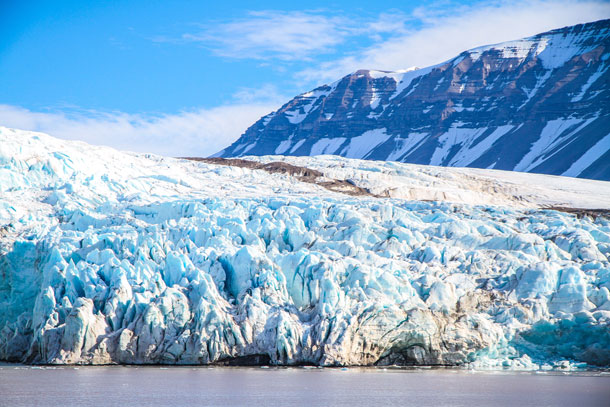
As glaciers shift and melt, many unsuspected sounds can emerge from the ice. (Photo: Unsplash, Vince Gx)
BASCOMB: When we see statistics and graphs about climate change, many of us may start to shut down, unwilling or unable to process one of the most serious environmental issues of our time. To draw people back into a conversation about our changing climate, researchers at the University of Virginia are using something called eco-acoustics – sounds that illustrate the relationship between humans and their environment. Reporter Sandy Hausman has the story.
HAUSMAN: Willis Jenkins teaches religious studies, but lately he’s been called to the coast, to record the sounds of sea level rise and oyster reefs.
JENKINS: When you hear the reef recording you’re going to hear a snapping or cracking sound, and that is actually pistol shrimp, and then you can also hear kind of micro-currents of water moving in and around the reef, and there may be a few low fish calls.”
HAUSMAN: People who hear that recording are drawn into dialogue.
JENKINS: The sound element is so captivating that people ask lots of questions about it, and then they begin to ask questions about organisms and data change over decades, in conversations that typically go longer than if I were to just tell you about the health of these wetlands.
HAUSMAN: His colleague in UVA’s music department agrees. Matthew Burtner is now working from a cabin near Anchorage, where he’s recording glaciers as they melt slowly --- or suddenly fall into the sea.
BURTNER: It’s an amazing symphony of sounds actually. There are incredibly low, booming sounds. They sound like jet engines up close as these large pieces of ice calve and fall, and then there are most delicate tinkling, trickling sounds that you’ve ever heard – these little tiny patterns of water moving across the ice as the ice melts and creates little tiny melodies, little tiny rhythms, and the whole surface of the glacier is just alive with sound.
HAUSMAN: After recording the sounds of the arctic, he translates climate data into notes and combines them to create compositions that tell the story of global warming. Hearing it, he says, is fundamentally different from reading or talking about climate change.
BURTNER: A lot happens when we shift our focus from looking at the world and moving in the world to just listening to the world. It’s a more contemplative way of being. If we could understand the glaciers as a complex symphony of sound the way we listen to Beethoven, that could do a lot for our relationship to the natural world.
HAUSMAN: The work itself is challenging. It was 65 degrees in Charlottesville when I reached Burtner in Alaska’s Chugach Mountains. There, he said, conditions were very different.
BURTNER: Today it’s three degrees and it’s snowing outside. You know, to do anything you have to shovel out and then you’re constantly trying to keep the equipment warm, because the equipment is not designed to function in sub-zero temperatures.
HAUSMAN: But he loves being outside in any weather, and recording off the Eastern Shore is a pleasure. He and Jenkins can now assess the health of an oyster reef through sound and monitor the size of crustaceans by listening to what they call crab flutes – sounds heard as the wind blows over holes in the sand.
BURTNER: We hoped to be able to record the crab, but the crab made almost no sound, and we couldn’t hear it, but we could hear the wind whistling over the top of the crab glute – this wind instrument that the crab has made.
HAUSMAN: You can hear Burtner’s work on his newly released album, Glacier Music on Revallo Records, featuring what will surely be a hit song entitled the “Syntax of Snow”.
For Living on Earth, I’m Sandy Hausman.
BASCOMB: Sandy Hausman’s story comes to us courtesy of WVTF in Charlottesville, Virginia.
Related links:
- Read the original story from WVTF
- More on Pistol Shrimp
[MUSIC: Snorre Kirk, “Pastorale” on Stunt Records Compilation Vol. 25, by Snorre Kirk, Sundance Music/Stunt Records]
BASCOMB: Coming up, what happens to a large family farm when the owners let nature take over. That’s just ahead on Living on Earth.
ANNOUNCER: Funding for Living on Earth comes from you, our listeners, and United Technologies, combining passion for science with engineering to create solutions designed for sustainability in aerospace, building industries, and food refrigeration. UTC companies such as Otis, Carrier, Pratt and Whitney, and UTC Aerospace systems are helping to move the world forward. You can learn more about United Technologies by tuning into the Race to Nine Billion podcast; listen at racetoninebillion.com. This is PRI, Public Radio International.
[CUTAWAY MUSIC: The David Grisman Quintet, “Dawganova” 1995 Acoustic Disc]
Rewilding The English Countryside
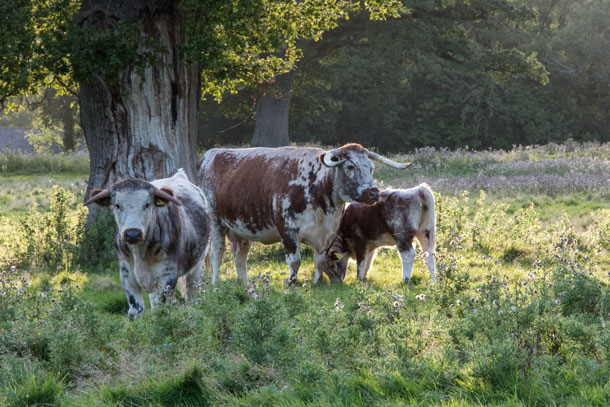
Longhorn cattle were chosen for the project to stand in for their extinct ancestor, the auroch. (Photo: Charlie Burrell / Knepp Estate Castle)
BASCOMB: It’s Living on Earth, I’m Bobby Bascomb.
When writer Isabella Tree, and her husband, Charlie Burrell, inherited an estate in West Sussex, England, they assumed they would continue to farm as generations of family had before them. But the intensive agriculture of their predecessors grew increasingly difficult, and they decided that farming was no longer a viable option. So they began to mull over another idea: Give the land back to nature and let it take its course. Isabella Tree’s recent book is titled Wilding, and it’s the story of what happened to the land when they gave up farming and let nature take the reins. Isabella joins us now. Welcome to Living on Earth!
TREE: Thank you. Lovely to be here.
BASCOMB: Thank you. So tell me briefly about your property and how it's traditionally been used. What did it look like before you started this re-wild project?
TREE: Well, I mean, we inherited this piece of land from my husband's grandparents. So, we inherited in about the 1980s. And it had been intensively farmed for ever since pretty much the second World War. So, when we took over it was a patchwork of very small fields with hedges and it was intensive, arable, and dairy farming. And we just simply assumed that's what we would continue to do for the rest of our lives, is carry on the family tradition and farm. But already when we took it over the farm was losing money hand over fist. So, we kept buying, you know, bigger machines, throwing more pesticide, more fertilizer, more nitrates, built bigger dairies and changed our types of cows to more higher-milk-yielding cows. So, it really did look pretty much like an intensive farm. And nature really wasn't part of that picture.
BASCOMB: Mmhmm. So what was your inspiration then, to take on a project like this. I mean, you could have just sold the property or leased it to someone else to farm.
TREE: Well, in a sense, we did lease it to someone else to farm because we tried contract farming. So, we sold all our farm equipment. It was a very, very black day. For us, we are part of a kind of long tradition of the family owning this land. Charlie's ancestors have been here since the Nash castle was built two hundred and twenty or so years ago. It really isn't for us an option to sell. We feel we're kind of stewards of this land, and we can't just sell up and move out. So, to look forward to the future, we really had to think of something else, to do something kind of with the land rather than against it.
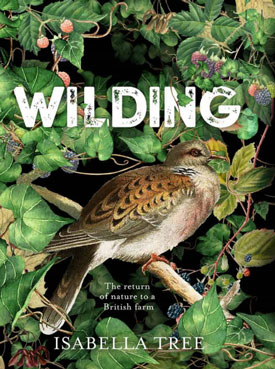
Isabella Tree is the author of Wilding, a book which documents the process she and her husband undertook to rewild their English estate. (Photo: Courtesy of Isabella Tree)
So, we tried contract farming for a little while. That is somebody else farming our land for us, trying to cut our overheads. But even then it proved unprofitable. We're on very, very heavy clay. That's the bane of our lives and I think the Inuit are supposed to have dozens of words for snow, at least that's how the myth goes. But in West Sussex, we have in old Sussex dialect over 30 different words for mud. And so, that made us very uncompetitive to farming. So, even our contract farmer was very willing to give up when we found an alternative, which was going back to nature.
BASCOMB: Well, how did you even come up with that alternative? I mean, for most farmers, I think it's probably pretty counterintuitive to just let the land go. I mean, that's not what you do as a farmer.
TREE: It is a very, very difficult thing to do, you're absolutely right. Going from intensive management, where you're really manipulating everything and tidying up and managing the land to the nth degree, to just sitting back and letting go is a massive mind swing.
BASCOMB: You talk a lot in your book about the importance of introducing herbivores. What animals did you introduce and why?
TREE: Well, we introduced... we had to introduce animals that we knew would be able to survive outside all year round without supplementary feeding, that would be able to fend for themselves even in a harsh or wet winter. So, we chose old breeds, we chose Old English Longhorn, wonderful cows with great white finching stripe down their backs and great big horns. And then Exmoor ponies, one of our oldest breeds of horse, they are fantastic at surviving, out in any landscape. Very, very hardy, indeed. And Tamworth pigs, another old breed that's very closely related to Iberian swine. So, they're the closest we felt that we could get with an English variety of pig to the wild boar. And then we had roe deer here already in low numbers. And then we introduced fallow deer and red deer.
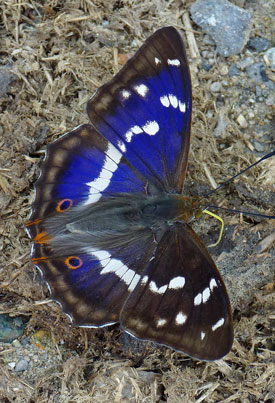
A male purple emperor butterfly – one of the hundreds of insect species that have been discovered in the rich, biodiverse Knepp ecosystem. (Photo: Charlie Burrell / Knepp Estate Castle)
BASCOMB: So, tell me about your property today. What does it look like? What does it smell like, even sound like, and how is that different from what you started with?
TREE: Oh, I mean, the first thing you notice, I think, when you walk around Knepp today is the sound of insects, for a start. On a day like this, it's a hot, sunny day, you've just got the sound of crickets and grasshoppers, you've got bees, you've got hover flies, you've got every sort of insect out there. It's thick with insects. If you go out there on a bicycle, you have to wear sunglasses or, you know, because you're getting insects in your eyes.
I mean, you know, we've forgotten that this used to be the norm 50 years ago. But in the era of pesticides, we just don't see insects anymore. So the sound of insects is astonishing. And then, of course you've got the bird song, surround sound bird song. Go out into the thickets, it's sort of like the African scrub. It's thorny scrub, its a patchwork of water meadows running into open grazed areas that the animals have a preference for gracing. You've got mature oak trees; again, a haven for insects and birds. It's a wonderful thing to be sitting in the middle of. But it's a double edged sword because we now go on walks in other places in the UK, places where we always used to enjoy, you know, an hour or two to walk, and now we notice what isn't there. And it's that, it’s what Aldo Leopold called that sadness, that tragedy of having an ecological education. You know what isn't there and what could be there, what should be there.
BASCOMB: So, which species came back on their own, or what were you most excited or surprised to see on your land?
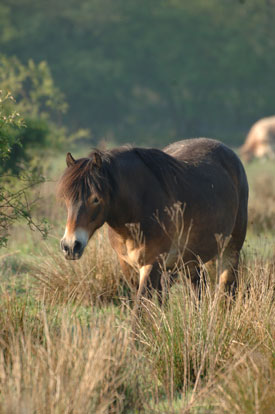
Exmoor ponies seem to be thriving, despite concerns that the clay in that part of England would be too soft for them. (Photo: Charlie Burrell / Knepp Estate Castle)
TREE: So, this is the thing. We literally haven't introduced anything apart from the free-roaming animals. So, they've all found us on their own. You know, we have 13 out of the 18 breeding species of bat in the UK. One of them called the Bechstein's bat is so rare, it's rare even in Europe, and we don't know much about it, it's that rare, but we have it at Knepp. We have Peregrine Falcons, we have them nesting in a tree. Usually you associate Peregrine falcons with cliffs and clifftops. They nest in steeples and cathedrals, but not in a tree. Nightingales are another species that is associated with woodland, but at Knepp they're taking up territories our exploding hedgerows and our thorny scrub. And so they're choosing a very different habitat because it's suddenly available to them. So, it's really changing the science books, we’ve forgotten that this is where nightingales love to be. And I think that's one of the lessons from Knepp, is that we're so used to seeing species in a very, very depleted landscape, that that's where we think they want to be. But in fact, they're often clinging on by their fingernails to habitat that just isn't optimal for them. And where they'd much rather be is in the kind of habitat that we're presenting for them at Knepp.
BASCOMB: But you had to stop short of actually creating a really native self sustaining ecosystem. You couldn't introduce predators there.
TREE: No, and we can't, we're obviously very constrained by where we are in the southeast of England and very busy area of the most densely populated part of Britain. We're underneath the Gatwick stacking system, where we have planes flying over us. We have roads all around us, we're in the middle of a very managed landscape. We certainly can't have predators where we are at Knepp, on three-and-a-half thousand acres, it's just tiny. It's nothing. Even a lynx requires a vast territory to survive. So, all we're trying to do really is to use tools that are available to us now in the environment in which we find ourselves, which is hugely transformed already by human impact. So, we're not trying to recreate the past in any way. We're just trying use a bit of inspiration from the past. And recognizing that herbivores in a landscape can trigger these extraordinary natural processes, the way they trample and rootle, the way they rip branches. The red deer will debark trees. So, you’re really letting them manage the landscape for you.
The only intervention we do is we cull them. So, we keep the numbers very low, because in the absence of predators, and also because we don't want to allow them to starve, which is what would happen in a huge system like Yellowstone or Serengeti. And in the process we, that provides us with a really useful income stream. So, we now produce 70 tons of meat a year, that's wonderful, sustainable, ethical, pasture-fed organic Longhorn beef and venison and pork. But because there are so few inputs, there's no agricultural buildings involved, there's no supplementary feeding, we're actually making way bigger profits – we’re actually making profits! Whereas before when we were farming, we rarely made a profit.
BASCOMB: How did your neighbors react when you said, you know what, we're just going to stop farming and let nature take its course.
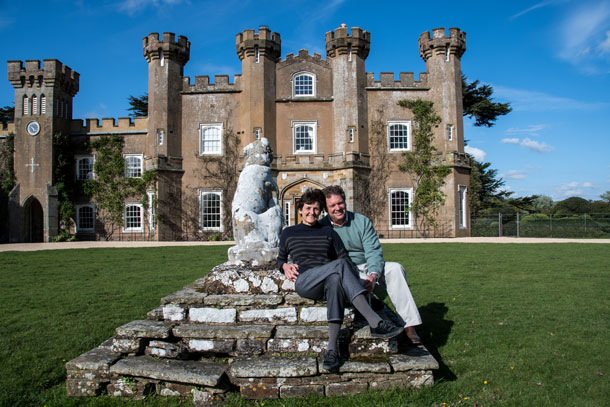
Isabella Tree and husband Charlie Burrell in front of their Knepp Castle Estate. (Photo: Charlie Burrell / Knepp Estate Castle)
TREE: It was very interesting. We held a meeting where we told them what we were going to do, and we invited them to join us and take part in this scheme and take advantage of the subsidies, the European subsidies, the higher level stewardship, agri-environment subsidies that were available to us. This we thought was a very positive message to be giving them, that you know, with, with farming going through the doldrums and especially on our soils, we really were facing a very, very uncertain future. And they are too, they still are, particularly post-Brexit. So, we assumed that we'd have a lot of people throwing their hats into the ring, but that wasn't the case at all. And I think if your family has been doing it for generations and generations, and if it's instilled in you and your kind of, your cultural ethos is that every inch of the land should be producing food -- which is a mentality we still have leftover from World War II even though now we know we are producing enough food to feed the planet and more -- if you feel every inch of the land needs to be managed and controlled, it's very difficult to embrace something that is messy and unpredictable. But interestingly, over the last few years, we’ve found the tide is beginning to turn.
As I say, I think post-Brexit people are really worried about the future. They've also seen how extraordinary the successes have been at Knepp. And I think those successes, compounded by the fact that we're looking the loss of EU subsidies in the face, is making people rethink. And we have a lot of landowners, farmers, policymakers and conservationists now pouring into Knepp to look at what we're doing, and if they can replicate something on their land.
BASCOMB: So, what advice would you have for other farmers that maybe aren't ready to jump in with two feet, but want to do some re-wilding on their land?
TREE: Obviously, if you're on Grade One, beautiful, lovely, loamy soil, and very productive land, you won't want to move away from farming, you're already making profits, and you've already got a sustainable business. But I think we really need to look at the whole landscape, and the nationwide level, even where farming is very profitable, and your kind of bread basket, you know, your huge, great swathes of arable land. It's a shame to think that nature doesn't belong there, and I so I think even in those areas that are completely given over to food production, we ought to be looking at giving some space, some percentage of the land.
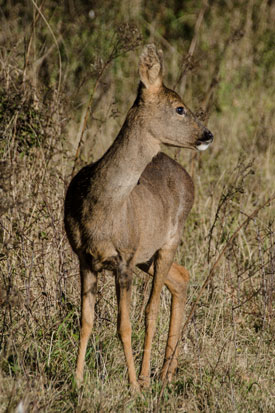
A Roe Deer. (Photo: Charlie Burrell / Knepp Estate Castle)
So, I think even if you're a small farmer, you can work in connection with neighbors to provide stepping stones or corridors, natural corridors to link other spaces for nature together. I think another thing, perhaps, is pop-up Knepps, this idea that you don't have to re-wild your land for forever, maybe you could just re-wild your land for, say, a generation, 25 or 30 years or so. And then once your soil is restored, once your water has been cleaned, you've had a period of sequestering carbon, you've provided habitat for insects and birds and other wildlife, then you can return it to sustainable agriculture. And that's very easy to do. You just, you know, put in these huge machines, these forestry machines that can take up all the thorny scrub and turn it back to a workable tilth in a matter of hours. But meanwhile, you've got areas around you that are beginning to re-wild, so they already have thorny scrub coming up. And that's where your turtle doves or where your nightingales will go when one area is returned to agriculture. So, you're really using it again on a rotational system, like the old farming system used to be where you let land lie fallow, but you're doing it on a much bigger scale over a much longer period of time.
BASCOMB: That is really interesting. It's a really, a really clever idea. It seems new, but as you said, a very old idea, really.
TREE: Yeah. And that way you can restore your soils. We're facing a crisis in the UK, as I think many places in the states are; in the UK, we have 100 harvests left before we have no topsoil in which to grow anything. I mean, it really is a terrifying thought. But re-wilding, we've seen from Knepp, can restore soil.
BASCOMB: Well, this sounds great, and so encouraging. But how do you actually make a living at it? I mean, I'm sure there are farmers here in the US that are struggling to make ends meet. It's a notoriously difficult business. But how do you still make money from your land? And how did you afford to take on such an elaborate project to begin with?
TREE: Well, I mean, that's exactly it. We were losing money hand over fist doing conventional farming. So, just giving up farming on this land, we cleared our overdraft, we cleared our debts. We've got this revenue, as I just described, coming in from our sort of organic, pasture-fed free-roaming animals. But we also have all these defunct agricultural buildings. And so with a bit of capital outlay, we can convert those into offices and storage space and space for light industrial use.
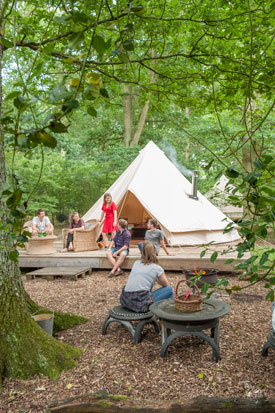
Knepp offers luxury campsites for rent on its grounds. Pictured – a group of “Glampers”. (Photo: Charlie Burrell / Knepp Estate Castle)
So, now that brings in considerable amount of rent. And then we've got our new eco-tourism business, that's been going for about five years now, because we've now got so much wildlife that you can come and see here, we thought, well, why not have safaris? You don't have to go to Africa to see exotic and exciting wildlife. And then we have glamping and camping, so a kind of African-style safari, luxury safari camp, and a pitch your own tent camp. And that ecotourism business now brings in 300,000 pounds a year, and we hope to be making about 20 percent profit on that.
BASCOMB: Well, what are your ambitions for the future of the estate? Where do you go from here?
TREE: Well, that is the wonderful thing about re-wilding, you never know. We would love to see beaver back at Knepp. We will be applying for a license to release beaver, and that is a new thing in England that we hope the government will support. They would be a fantastic contributor to some hydrological engineering that would produce wonderful results for biodiversity. Maybe one day we'll see bison arriving, we’ll see the English government accepting that bison could be back. Perhaps we'll even see wild boar breaking through our perimeter fence because we can't, by law, we can't release them, but they we know they're in the vicinity. So, if they arrive here, there'll be allowed to stay. It's just a question of hoping that our delightful Tamworth pigs will entice them in.
BASCOMB: [LAUGHS] Isabella Tree is an award winning author and travel writer. Isabella, thank you so much for sharing your story with me.
TREE: My pleasure. Great to talk to you.
[MUSIC: Claire Jones/Royal Harp Strings, “10 Woodland Sketches”]
Related links:
- Rewilding Book
- Knepp Castle Estate
- Isabella Tree Author Website
BASCOMB: Living on Earth is produced by the World Media Foundation. Our crew includes Naomi Arenberg, Diego Arenas, Paloma Beltran, Thurston Briscoe, Jenni Doering, Jay Feinstein, Merlin Haxhiymeri, Don Lyman, Lizz Malloy, Aynsley O’Neill, Jake Rego, and Jolanda Omari. Tom Tiger engineered our show. Alison Lirish Dean composed our themes. You can hear us anytime at LOE.org, iTunes and Google Play- and like us, please, on our Facebook page - PRI’s Living on Earth. We tweet from @livingonearth. And find us on Instagram at livingonearthradio. Steve Curwood will be back next week. I’m Bobby Bascomb. Thanks for listening!
ANNOUNCER: Funding for Living on Earth comes from you, our listeners, and from the University of Massachusetts, Boston, in association with its School for the Environment, developing the next generation of environmental leaders. And from the Grantham Foundation for the protection of the environment, supporting strategic communications and collaboration in solving the world’s most pressing environmental problems. Support also comes from the Energy Foundation, serving the public interest by helping to build a strong, clean, energy economy.
ANNOUNCER 2: PRI, Public Radio International.
Living on Earth wants to hear from you!
Living on Earth
62 Calef Highway, Suite 212
Lee, NH 03861
Telephone: 617-287-4121
E-mail: comments@loe.org
Newsletter [Click here]
Donate to Living on Earth!
Living on Earth is an independent media program and relies entirely on contributions from listeners and institutions supporting public service. Please donate now to preserve an independent environmental voice.
NewsletterLiving on Earth offers a weekly delivery of the show's rundown to your mailbox. Sign up for our newsletter today!
 Sailors For The Sea: Be the change you want to sea.
Sailors For The Sea: Be the change you want to sea.
 The Grantham Foundation for the Protection of the Environment: Committed to protecting and improving the health of the global environment.
The Grantham Foundation for the Protection of the Environment: Committed to protecting and improving the health of the global environment.
 Contribute to Living on Earth and receive, as our gift to you, an archival print of one of Mark Seth Lender's extraordinary wildlife photographs. Follow the link to see Mark's current collection of photographs.
Contribute to Living on Earth and receive, as our gift to you, an archival print of one of Mark Seth Lender's extraordinary wildlife photographs. Follow the link to see Mark's current collection of photographs.
 Buy a signed copy of Mark Seth Lender's book Smeagull the Seagull & support Living on Earth
Buy a signed copy of Mark Seth Lender's book Smeagull the Seagull & support Living on Earth

